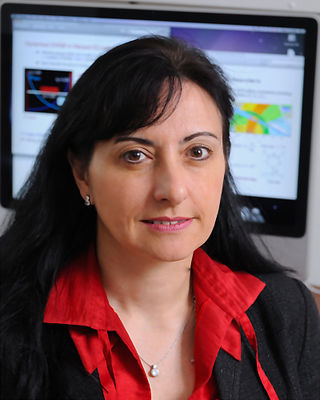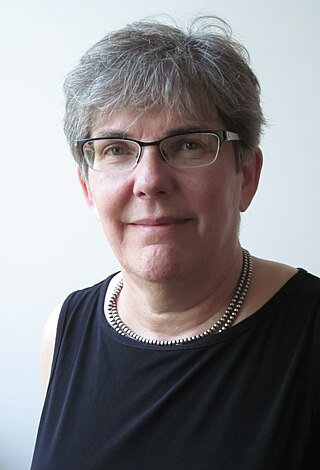
Melissa Eve Bronwen Franklin is an experimental particle physicist and the Mallinckrodt Professor of Physics at Harvard University. In 1992, Franklin became the first woman to receive tenure in the Physics department at Harvard University and she served as Chair of the department from 2010 to 2014. While working at Fermi National Accelerator Laboratory in Chicago, her team found some of the first evidences for the existence of the top quark. In 1993, Franklin was elected a fellow of the American Physical Society. She is currently member of the CDF (Fermilab) and ATLAS (CERN) collaborations.

The DØ experiment was a worldwide collaboration of scientists conducting research on the fundamental nature of matter. DØ was one of two major experiments located at the Tevatron Collider at Fermilab in Batavia, Illinois. The Tevatron was the world's highest-energy accelerator from 1983 until 2009, when its energy was surpassed by the Large Hadron Collider. The DØ experiment stopped taking data in 2011, when the Tevatron shut down, but data analysis is still ongoing. The DØ detector is preserved in Fermilab's DØ Assembly Building as part of a historical exhibit for public tours.
JADE was a particle detector at the PETRA particle accelerator at the German national laboratory DESY in Hamburg. It was operated from 1979 to 1986. JADE's most important scientific achievement was the discovery of the gluon in three-jet events. It also helped greatly in establishing quantum chromodynamics. JADE is an acronym for Japan, Deutschland (Germany) and England, the three countries from which the participating universities originated. The JADE jet chamber is now exhibited in the physics lecture hall at the University of Heidelberg. Although the last data with JADE were taken in 1986, analysis continued, with the most recent paper published in 2012. In 1995, the European Physical Society (EPS) awarded a "Special High Energy and Particle Physics Prize" to the JADE, PLUTO, TASSO and MARK-J collaborations at PETRA for "establishing the existence of the gluon in independent and simultaneous ways".
In particle physics, a B-factory, or sometimes a beauty factory, is a particle collider experiment designed to produce and detect a large number of B mesons so that their properties and behavior can be measured with small statistical uncertainty. Tau leptons and D mesons are also copiously produced at B-factories.

Marcela Silvia Carena Lopez is a theoretical physicist, and Distinguished Scientist at the Fermi National Accelerator Laboratory in Batavia, Illinois, where she is also head of the lab's Theory Division. She is also a professor at the University of Chicago, where she is a member of the Enrico Fermi Institute and the Kavli Institute for Cosmological Physics.

ARGUS was a particle physics experiment that ran at the electron–positron collider ring DORIS II at the German national laboratory DESY. Its aim was to explore properties of charm and bottom quarks. Its construction started in 1979, the detector was commissioned in 1982 and operated until 1992.
Invenio is an open source software framework for large-scale digital repositories that provides the tools for management of digital assets in an institutional repository and research data management systems. The software is typically used for open access repositories for scholarly and/or published digital content and as a digital library.
Michael John Creutz is an American theoretical physicist at Brookhaven National Laboratory specializing in lattice gauge theory and computational physics.

James Daniel "BJ" Bjorken is an American theoretical physicist. He was a Putnam Fellow in 1954, received a BS in physics from MIT in 1956, and obtained his PhD from Stanford University in 1959. He was a visiting scholar at the Institute for Advanced Study in the fall of 1962. Bjorken is Emeritus Professor in the SLAC Theory Group at the Stanford Linear Accelerator Center, and was a member of the Theory Department of the Fermi National Accelerator Laboratory (1979–1989).
INSPIRE-HEP is an open access digital library for the field of high energy physics (HEP). It is the successor of the Stanford Physics Information Retrieval System (SPIRES) database, the main literature database for high energy physics since the 1970s.

Michael Stewart Witherell is an American physicist and laboratory director. He has been the director of the Lawrence Berkeley National Laboratory since 2016. Witherell, a particle physicist, previously served as Director of Fermilab. He was a particle physicist at the University of California, Santa Barbara and also served as vice chancellor for research there.

Patricia Burchat is the Gabilan Professor of Physics at Stanford University who researches experimental particle physics and cosmology. She is interested in mapping dark matter in the universe, and understanding the nature of dark energy. She was named a fellow of the American Physical Society in 2001, and a Guggenheim Fellow in 2005. In 2013 she became a fellow of the American Association for the Advancement of Science.

Heidi Marie Schellman is an American particle physicist at Oregon State University (OSU), where she heads the Department of Physics. She is an expert in Quantum chromodynamics.
Michel Davier is a French physicist.
Natalie Ann Roe is an experimental particle physicist and observational cosmologist, and the Associate Laboratory Director for the Physical Sciences Area at Lawrence Berkeley National Laboratory (LBNL) since 2020. Previously, she was the Physics Division Director for eight years. She has been awarded as the Fellow of American Physical Society (APS) and American Association for the Advancement of Science (AAAS) for her exceptional scientific career and contributions.
Joshua A. Frieman is a theoretical astrophysicist who lives and works in the United States. He is a senior scientist at Fermilab and a professor of astronomy and astrophysics at the University of Chicago. Frieman is known for his work studying dark energy and cosmology, and he co-founded the Dark Energy Survey experiment. He was elected a member of the National Academy of Sciences in 2022.
Nikolitsa (Lia) Merminga is a Greek-born accelerator physicist. In 2022, she was appointed director of Fermi National Accelerator Laboratory, the first woman to hold the position. She has worked at other national laboratories in Canada and the United States.
Amber S. Boehnlein is a particle physicist, computer scientist, and administrator who has held leadership positions at several United States national laboratories and the United States Department of Energy.
Donald J. Summers was a particle physicist who worked on experiments at several labs, including Fermilab, CERN, SLAC, and KEK.
Arden Warner is a Barbadian-American particle physicist and inventor, working at the Fermi National Accelerator Laboratory (Fermilab), notable for the creation of a novel environmentally positive, magnetism-based method for cleaning up oil spills, now being developed by Fermilab and a company led by Warner.








